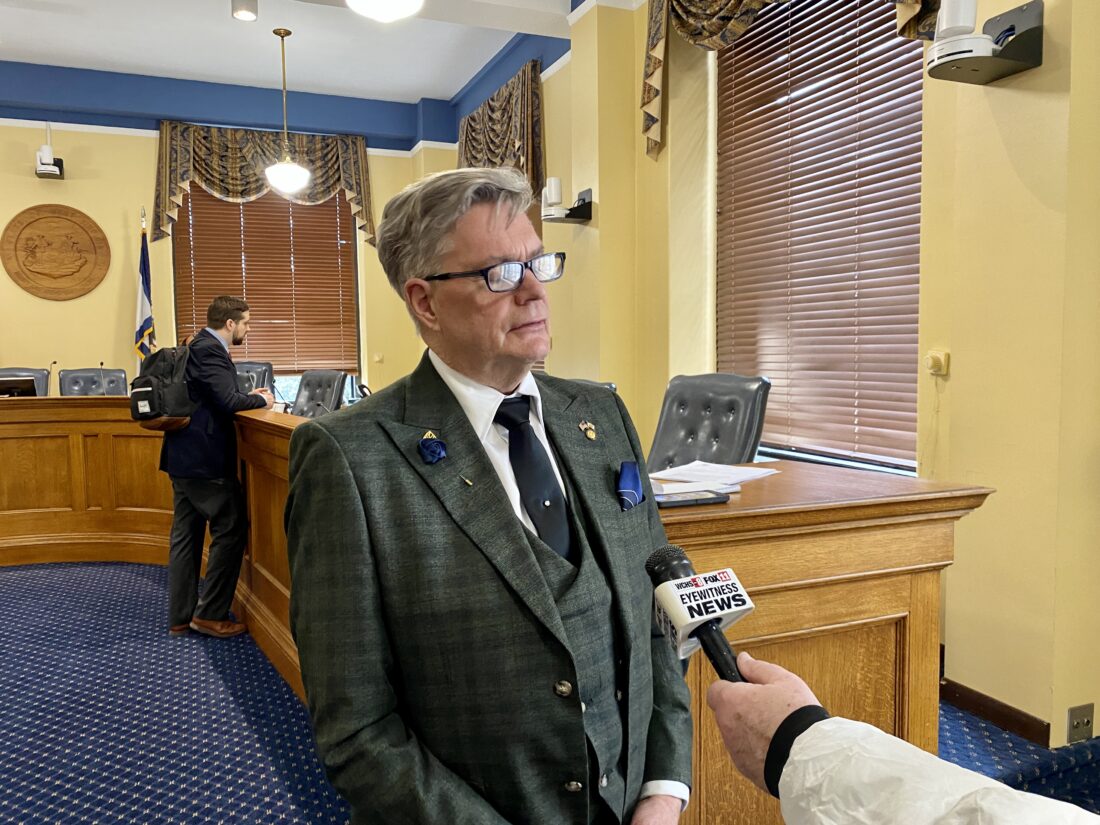Staffing Levels at West Virginia Prisons Still at Crisis Level

photo by: Photo by Steven Allen Adams
Delegate David Kelly said that a new draft bill to address correctional officer pay and per-diem jail fees will be introduced during the 2023 legislative session beginning this week.
CHARLESTON – Staffing vacancies for officers and support staff in West Virginia’s correctional system are at the highest levels seen.
Members of the Legislature’s Oversight Committee on Regional Jail and Correctional Facility Authority heard a report Tuesday afternoon from Brad Douglas, acting commissioner of West Virginia Division of Corrections and Rehabilitation, on year-end staffing levels, inmate populations and facility maintenance.
According to data from the DCR, quarterly staff vacancies for the state’s 11 prisons, 10 regional jails, 10 juvenile centers and three work-release sites was 1,027 as of the end of December, a 26% increase from the next highest vacancy number of 813 at the beginning of January 2019.
“It’s a 33% vacancy rate for officers and a 27% vacancy rate overall,” Douglas said. “It’s slowly getting worse. I do have a little bit of hope … that it’s slowing down.”
Douglas said the vacancy problem is particularly acute in the Eastern Panhandle, where West Virginia competes with neighboring Virginia and Maryland that offer higher pay and benefits. For example, the Potomac Highlands Regional Jail has a 75% vacancy rate for correctional officers and staff. The Vicki Douglas Juvenile Center in Martinsburg has a 58% vacancy rate.
Gov. Jim Justice declared a state of emergency for West Virginia prisons and regional jails in August, citing severe staffing shortages. Justice ordered the West Virginia National Guard to assist with staffing needs. The agreement between the National Guard and the Department of Homeland Security can last no longer than this August, though it could be extended if staffing shortages continue.
Douglas said there are 300 National Guard members in jails and prisons working in control posts and other areas with no direct contact with prisoners. Douglas also confirmed officers with the Division of Natural Resources also are assisting DCR. There were 9,812 people in the state’s correctional system, 5,100 in prisons and 4,712 in the regional jails as of Dec. 6.
This is the second time Justice declared a state of emergency for prison staffing shortages. In December 2017, he issued the declaration empowering DHS Cabinet Secretary Jeff Sandy to pull staff temporarily from other agencies and employ the use of the National Guard. That state of emergency ended in August 2018.
According to DCR, the base salary for a correctional officer class 1 is $33,214 as of July, with a 7% pay increase to $35,360 for correctional officers after their first year on the job and a promotion to correctional officer class 2. After the second year, salaries increase another 7% to $37,656 and a promotion to correctional officer class 3.
Douglas said that despite their recruiting efforts and improvements in the base pay, the DCR is still struggling to hire new staff and retain existing staff. As of October, DCR implemented a $1,000 appointment incentive to entice new recruits. Douglas said the incentive has been paid out 44 times since October.
“Forty-five officer hires in a month-and-a-half period is pretty good,” Douglas said. “I’m hoping with all these things coming together that it’s going to start turning the tide a little, but it’s too early to say.”
Lawmakers will consider a bill during the 60-day legislative session to provide more funding for the state’s correctional system. It would increase base salary for correctional officers based on years of service, with a $600 increase for the first five years of service and a $600 increase every three years thereafter. The increase would also be retroactive to current correctional officers that meet the criteria for years of service.
“I know that this committee has heard in the past that recruitment is a problem, but retention is also a problem,” said Will Valentino, chief counsel for the House Judiciary Committee. “This is one way to address retention.”
The bill would allow the DCR commissioner to increase base pay based on rank and length of service on top of the minimal requirements. The salary levels were left blank to give DCR the opportunity to recommend the specific salary levels to be amended into the bill later.
Correctional officers would receive a $60 biweekly subsistence allowance to help cover the expense of phones, dry cleaning and uniforms, and meal expenses while on duty. The bill would also require cities and municipalities to pay the per-day costs of people arrested by municipal police departments and incarcerated in regional jail for the first five days.
“We’ve heard from the counties that any cases that go to magistrate court, regardless of the agency arresting that person, are billed to the county,” Valentino said.
Committee Chairman David Kelly, R-Tyler, said the House Jails and Prisons Committee will take up the draft bill quickly.
“We’ll be continuing this issue there,” Kelly said. “We can’t hire enough correctional officers … it’s a hiring issue but it’s also a retention issue. We’ve got to keep these officers once they get hired. But it’s also a county issue too. They’re struggling to keep up with the per diem. We have multiple issues we’re going to try to address.”
Lawmakers also expect to debate a bill that would create a locality pay program for correctional officers. A similar bill never made it out of the House of Delegates last year.
- Delegate David Kelly said that a new draft bill to address correctional officer pay and per-diem jail fees will be introduced during the 2023 legislative session beginning this week.






